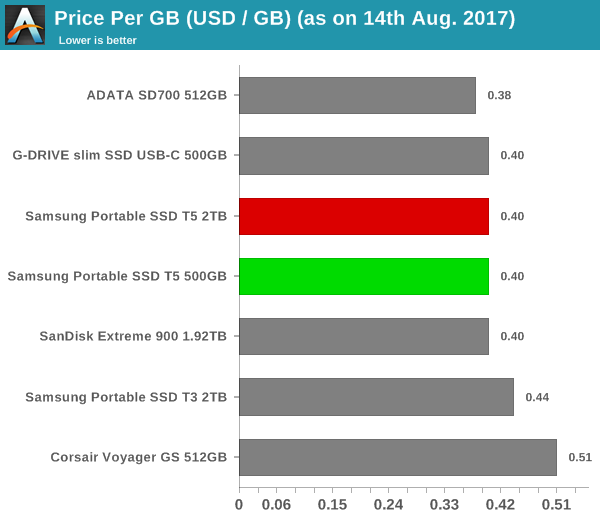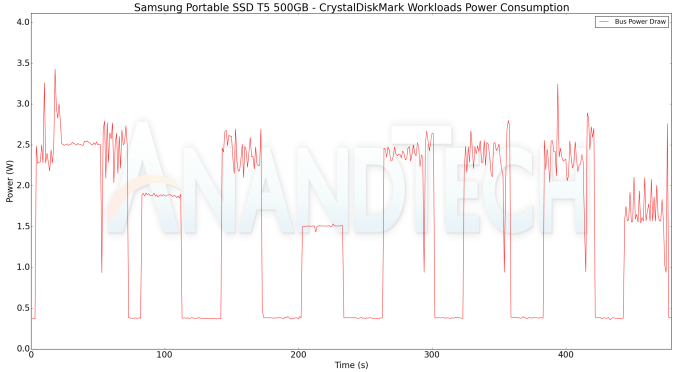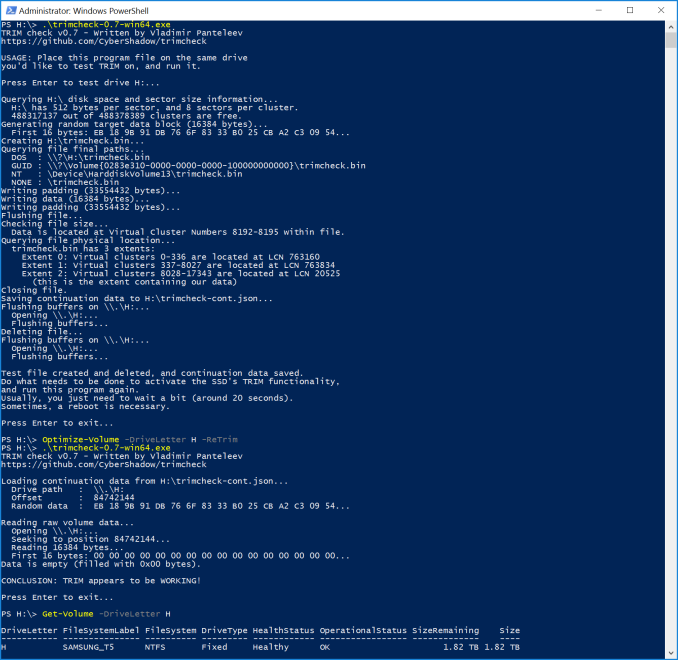Samsung Portable SSD T5 Review: 64-Layer V-NAND Debuts in Retail
by Ganesh T S on August 15, 2017 10:00 AM ESTMiscellaneous Aspects and Concluding Remarks
The impacts of enabling encryption on Samsung's Portable SSDs had been evaluated in the review of the T1 itself. The controller (responsible for the encryption, amongst other things) has not changed between the T1 and the T5. So, we ran a few tests to confirm that enabling encryption didn't have any discernible performance impact.
The Portable SSD T5 is a bus-powered device, and it is given that the peak power consumption can't go beyond 5W to maintain compatibility with as wide a range of systems as possible. It is still relevant to take a fine-grained look at the power consumption profile. Using the Plugable USBC-TKEY, the bus power consumption for both SSDs was tracked while the CrystalDiskMark workloads were processed. The workloads were set up with an interval time of 30s.
The 500GB variant idles at arond 0.38W and has a peak power consumption of 3.43W.
The 2TB version also behaves similarly - idling at 0.40W and a 3.40W peak power consumption.
Support for TRIM is a much more interesting feature, given that neither the T1 nor T3 supported it. Though Samsung doesn't officially claim TRIM support for the T5, we formatted one of the drives in NTFS to verify the status.
We were pleasantly surprised to find that TRIM was enabled. It is likely that the new ASMedia bridge chip has contributed to the availability of this feature.
Moving on to the pricing aspect, it must be remembered that the Portable SSD T5 is a pilot vehicle for Samsung's 64-layer V-NAND as its production ramps up. Samsung naturally expects this to be a low-volume, high-margin part. Therefore, despite the higher density, consumers should not expect much difference in the cost per GB compared to other external SSDs in the market. The 2TB variant will have a MSRP of $800 and the 500GB will retail at $200. At 40 cents/GB, it is priced close to other such products currently in the market.

Coming to the business end of the review, Samsung must be commended for finally enabling TRIM in the Portable SSD series. The thermal design for such compact products is always challenging, and Samsung has done a decent job of keeping temperatures below 70C even under extreme stress. However, there is always scope for improvement.
In terms of future products in this lineup, Samsung could experiment with more compact form factors / thumb-drive type designs (similar to the Corsair Voyager GS / GTX series). Samsung had talked about targeting the content capture community with the T5 SSDs. Making an impact in that market segment requires additional features - water-proofing and dust-proofing are appreciated. For example, the ADATA SD700 available at a slightly better price point (in terms of USD/GB) carries an IP68 rating. In addition, a RAID-ed design similar to the SanDisk Extreme 900 or Netac Z5 can also help in boosting performance to take advantage of the full capabilities of the USB 3.1 Gen 2 interface.













38 Comments
View All Comments
timecop1818 - Tuesday, August 15, 2017 - link
what workload on a Macintosh would require so much data transfer anyway? you don't need 3000mb/sec to stare at a desktop or play candy crushjdshewman - Wednesday, August 16, 2017 - link
Photographers, HD and 4K video. With the abundance of travel bloggers and drones, extra storage with speed is valuable.AnTech - Thursday, August 17, 2017 - link
Which one? Any of these or is there anyone else coming?Sonnet Fusion Thunderbolt 3 PCIe Flash Drive
http://www.sonnettech.com/product/fusiontb3pciefla...
JMR Lightning LTNG-XTD portable Thunderbolt SSD
http://jmr.com/product/jmr-lightningltng-xtd-porta...
name99 - Wednesday, August 16, 2017 - link
Of course it is. Macs have handled booting from external drives since forever (at least the initial FireWire days). I run my iMac 2012 off an external USB3 SSD because the internal HD failed. Hell, you can even create a fusion boot drive between an external SSD and an internal hard drive if you like, and that's how I run my 2007 iMac (SSD connected via FW800).Being able to boot painlessly from external drives is one of the great Mac advantages that Win and Linux folks don't seem to know about because it's not part of their world. I do it all the time, sometimes for machines whose internal drives die, sometimes to give a speed boost to an old machine (like the 2007 iMac setup I described above), sometimes as a diagnostic when a machine seems to be behaving badly. (Good way to learn/test that an internal HD is going bad...)
Obviously you will want to format the external drive to JHFS+ (or wait two months and format it to APFS...), you can't boot off exFAT or NTFS or whatever it comes formatted with.
VulkanMan - Tuesday, August 15, 2017 - link
How long can these retain the data without being powered?Is that information included anywhere?
coder543 - Tuesday, August 15, 2017 - link
No one lists that information for any SSD that I've seen, but the minimum JEDEC spec for a consumer SSD is one year without power. Realistically, I have trouble imagining less than 5 years being a problem, but it would be interesting to have numbers.VulkanMan - Tuesday, August 15, 2017 - link
Most SSDs have been internal and those usually get powered up daily / weekly.Since these are external, not everyone is going to know that they must power the devices up at least once every X months, so they shouldn't be used for long term storage.
I would think they would put warnings on these that data loss is possible if you don't power them up semi-frequently.
Billy Tallis - Tuesday, August 15, 2017 - link
Powering up the drive periodically or even continuously doesn't solve anything. All of the data has to be moved or re-written in order to prolong retention times. But since those retention times are measured in years not months, it's not worth warning about.Billy Tallis - Tuesday, August 15, 2017 - link
JEDEC spec is for one year of unpowered data retention after the drive's rated write endurance has been exhausted. A drive that hasn't been absolutely hammered with writes will retain data far longer.Bullwinkle J Moose - Tuesday, August 15, 2017 - link
I'll stick with an 850 Pro because it works on any USB 3 and 3.1 port with an adapterThe 850 Pro is faster than this drive as well
I avoid "USB Only" external drives because you can only install Windows 2 Go Spyware Platforms on them
With the 850 Pro, I can also install Windows XP and use it with SATA and ESATA ports as well as any USB port
With this one, you are stuck with USB only
So sad!